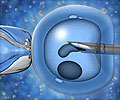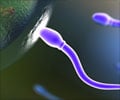Close proximity with a female—something that occurs in a majority of species, including humans—results in the ejaculates from two or more males overlapping within her reproductive tract.

Until now, traits and processes that influence fertilization success have been poorly understood, due to the challenges of observing what sperm do within the female's body and of discriminating sperm among different males. Almost nothing is known about what determines the sperm's fate in hybrid matings where there may be an evolutionary mismatch between ejaculate and female reproductive tract traits.
Professor John Belote has overcome these challenges by genetically engineering closely related species of fruit flies with different colors of glow-in-the-dark-sperm. Working closely with Scott Pitnick, Mollie Manier, and other colleagues in SU's Pitnick Lab, he is able to observe ejaculate-female interactions and sperm competition in hybrid matings.
"How new species arise is one of the most important questions facing biologists, and we still have a lot to learn," says Pitnick, a professor in SU's Department of Biology in The College of Arts and Sciences, adding that the mechanisms maintaining the genetic boundary between species is difficult to pin down. "This paper [in Current Biology] is perhaps the most important one of my career. It has been six years in the making."
Belote, also a professor in the Department of Biology, says that sexual selection research has addressed mainly precopulatory, rather than postcopulatory selection. This disparity is due, in part, to the aforementioned difficulties of studying ejaculate-ejaculate and ejaculate-female interactions.
"By focusing on phenotypic divergence [i.e., the genetic make-up and environmental influences] between sister species in postcopulatory sexual selection, we can predict patterns of reproductive isolation and the causal mechanisms underlying such isolation," he says.
Source-Eurekalert













